Jiaxin Ding
TopInG: Topologically Interpretable Graph Learning via Persistent Rationale Filtration
Oct 06, 2025Abstract:Graph Neural Networks (GNNs) have shown remarkable success across various scientific fields, yet their adoption in critical decision-making is often hindered by a lack of interpretability. Recently, intrinsically interpretable GNNs have been studied to provide insights into model predictions by identifying rationale substructures in graphs. However, existing methods face challenges when the underlying rationale subgraphs are complex and varied. In this work, we propose TopInG: Topologically Interpretable Graph Learning, a novel topological framework that leverages persistent homology to identify persistent rationale subgraphs. TopInG employs a rationale filtration learning approach to model an autoregressive generation process of rationale subgraphs, and introduces a self-adjusted topological constraint, termed topological discrepancy, to enforce a persistent topological distinction between rationale subgraphs and irrelevant counterparts. We provide theoretical guarantees that our loss function is uniquely optimized by the ground truth under specific conditions. Extensive experiments demonstrate TopInG's effectiveness in tackling key challenges, such as handling variform rationale subgraphs, balancing predictive performance with interpretability, and mitigating spurious correlations. Results show that our approach improves upon state-of-the-art methods on both predictive accuracy and interpretation quality.
Way to Specialist: Closing Loop Between Specialized LLM and Evolving Domain Knowledge Graph
Nov 28, 2024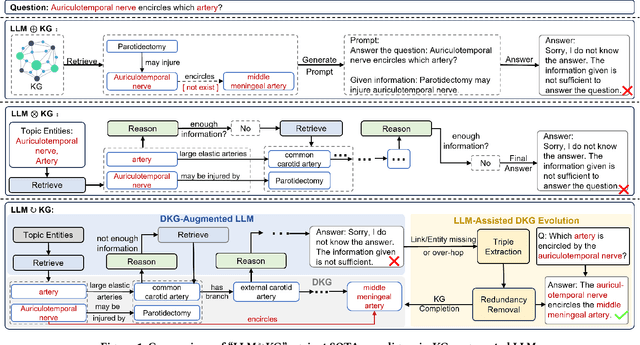
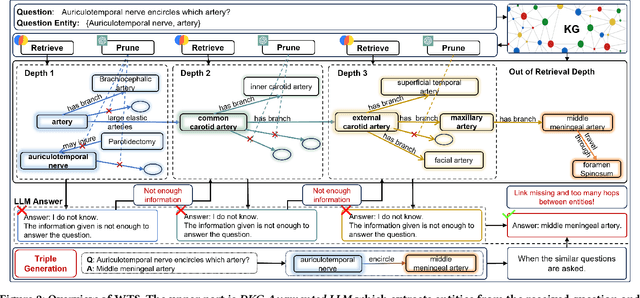
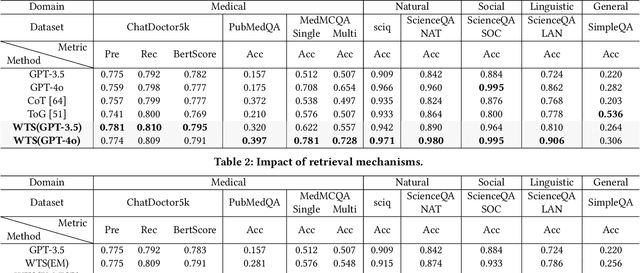
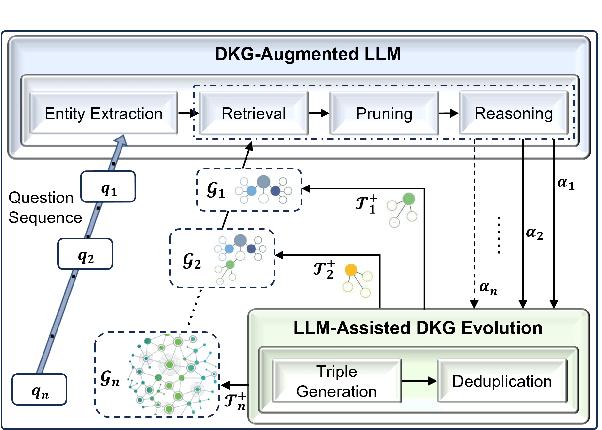
Abstract:Large language models (LLMs) have demonstrated exceptional performance across a wide variety of domains. Nonetheless, generalist LLMs continue to fall short in reasoning tasks necessitating specialized knowledge. Prior investigations into specialized LLMs focused on domain-specific training, which entails substantial efforts in domain data acquisition and model parameter fine-tuning. To address these challenges, this paper proposes the Way-to-Specialist (WTS) framework, which synergizes retrieval-augmented generation with knowledge graphs (KGs) to enhance the specialized capability of LLMs in the absence of specialized training. In distinction to existing paradigms that merely utilize external knowledge from general KGs or static domain KGs to prompt LLM for enhanced domain-specific reasoning, WTS proposes an innovative "LLM$\circlearrowright$KG" paradigm, which achieves bidirectional enhancement between specialized LLM and domain knowledge graph (DKG). The proposed paradigm encompasses two closely coupled components: the DKG-Augmented LLM and the LLM-Assisted DKG Evolution. The former retrieves question-relevant domain knowledge from DKG and uses it to prompt LLM to enhance the reasoning capability for domain-specific tasks; the latter leverages LLM to generate new domain knowledge from processed tasks and use it to evolve DKG. WTS closes the loop between DKG-Augmented LLM and LLM-Assisted DKG Evolution, enabling continuous improvement in the domain specialization as it progressively answers and learns from domain-specific questions. We validate the performance of WTS on 6 datasets spanning 5 domains. The experimental results show that WTS surpasses the previous SOTA in 4 specialized domains and achieves a maximum performance improvement of 11.3%.
AceParse: A Comprehensive Dataset with Diverse Structured Texts for Academic Literature Parsing
Sep 16, 2024Abstract:With the development of data-centric AI, the focus has shifted from model-driven approaches to improving data quality. Academic literature, as one of the crucial types, is predominantly stored in PDF formats and needs to be parsed into texts before further processing. However, parsing diverse structured texts in academic literature remains challenging due to the lack of datasets that cover various text structures. In this paper, we introduce AceParse, the first comprehensive dataset designed to support the parsing of a wide range of structured texts, including formulas, tables, lists, algorithms, and sentences with embedded mathematical expressions. Based on AceParse, we fine-tuned a multimodal model, named AceParser, which accurately parses various structured texts within academic literature. This model outperforms the previous state-of-the-art by 4.1% in terms of F1 score and by 5% in Jaccard Similarity, demonstrating the potential of multimodal models in academic literature parsing. Our dataset is available at https://github.com/JHW5981/AceParse.
Unlock the Power of Frozen LLMs in Knowledge Graph Completion
Aug 13, 2024Abstract:Classical knowledge graph completion (KGC) methods rely solely on structural information, struggling with the inherent sparsity of knowledge graphs (KGs). Large Language Models (LLMs) learn extensive knowledge from large corpora with powerful context modeling, which is ideal for mitigating the limitations of previous methods. Directly fine-tuning LLMs offers great capability but comes at the cost of huge time and memory consumption, while utilizing frozen LLMs yields suboptimal results. In this work, we aim to leverage LLMs for KGC effectively and efficiently. We capture the context-aware hidden states of knowledge triples by employing prompts to stimulate the intermediate layers of LLMs. We then train a data-efficient classifier on these hidden states to harness the inherent capabilities of frozen LLMs in KGC. We also generate entity descriptions with subgraph sampling on KGs, reducing the ambiguity of triplets and enriching the knowledge representation. Extensive experiments on standard benchmarks showcase the efficiency and effectiveness of our approach. We outperform classical KGC methods on most datasets and match the performance of fine-tuned LLMs. Additionally, compared to fine-tuned LLMs, we boost GPU memory efficiency by \textbf{$188\times$} and speed up training+inference by \textbf{$13.48\times$}.
Exterior Penalty Policy Optimization with Penalty Metric Network under Constraints
Jul 22, 2024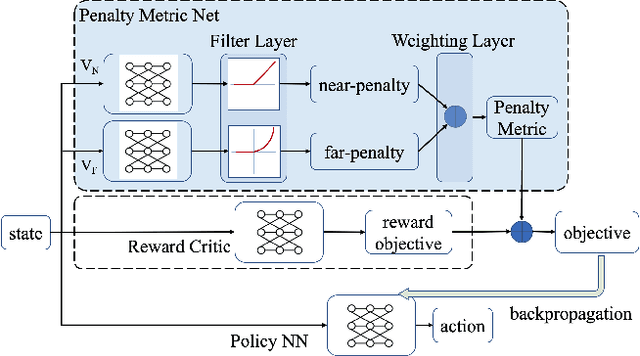
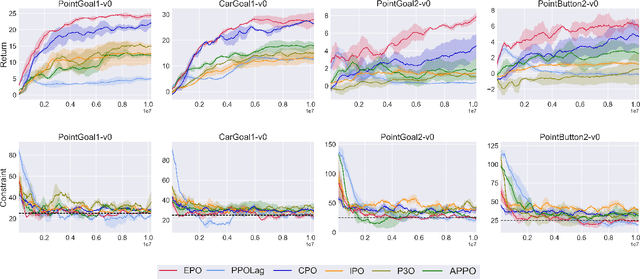
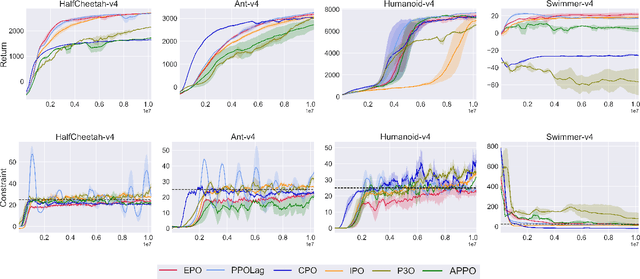
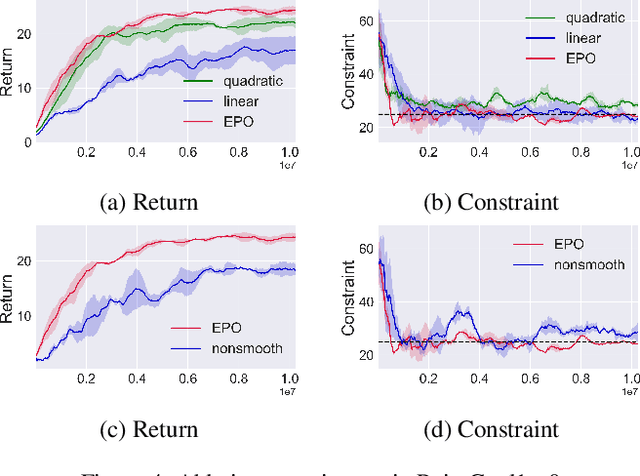
Abstract:In Constrained Reinforcement Learning (CRL), agents explore the environment to learn the optimal policy while satisfying constraints. The penalty function method has recently been studied as an effective approach for handling constraints, which imposes constraints penalties on the objective to transform the constrained problem into an unconstrained one. However, it is challenging to choose appropriate penalties that balance policy performance and constraint satisfaction efficiently. In this paper, we propose a theoretically guaranteed penalty function method, Exterior Penalty Policy Optimization (EPO), with adaptive penalties generated by a Penalty Metric Network (PMN). PMN responds appropriately to varying degrees of constraint violations, enabling efficient constraint satisfaction and safe exploration. We theoretically prove that EPO consistently improves constraint satisfaction with a convergence guarantee. We propose a new surrogate function and provide worst-case constraint violation and approximation error. In practice, we propose an effective smooth penalty function, which can be easily implemented with a first-order optimizer. Extensive experiments are conducted, showing that EPO outperforms the baselines in terms of policy performance and constraint satisfaction with a stable training process, particularly on complex tasks.
RepEval: Effective Text Evaluation with LLM Representation
Apr 30, 2024Abstract:Automatic evaluation metrics for generated texts play an important role in the NLG field, especially with the rapid growth of LLMs. However, existing metrics are often limited to specific scenarios, making it challenging to meet the evaluation requirements of expanding LLM applications. Therefore, there is a demand for new, flexible, and effective metrics. In this study, we introduce RepEval, the first metric leveraging the projection of LLM representations for evaluation. RepEval requires minimal sample pairs for training, and through simple prompt modifications, it can easily transition to various tasks. Results on ten datasets from three tasks demonstrate the high effectiveness of our method, which exhibits stronger correlations with human judgments compared to previous metrics, even outperforming GPT-4. Our work underscores the richness of information regarding text quality embedded within LLM representations, offering insights for the development of new metrics.
Characterizing the Influence of Topology on Graph Learning Tasks
Apr 11, 2024

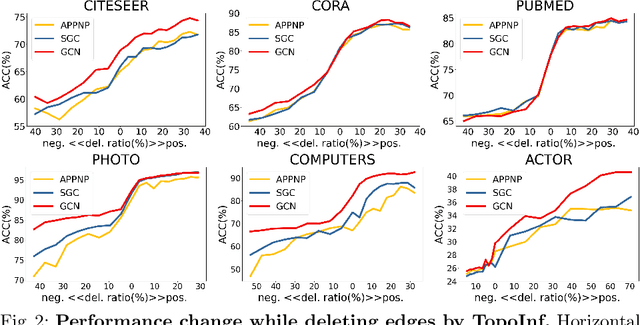

Abstract:Graph neural networks (GNN) have achieved remarkable success in a wide range of tasks by encoding features combined with topology to create effective representations. However, the fundamental problem of understanding and analyzing how graph topology influences the performance of learning models on downstream tasks has not yet been well understood. In this paper, we propose a metric, TopoInf, which characterizes the influence of graph topology by measuring the level of compatibility between the topological information of graph data and downstream task objectives. We provide analysis based on the decoupled GNNs on the contextual stochastic block model to demonstrate the effectiveness of the metric. Through extensive experiments, we demonstrate that TopoInf is an effective metric for measuring topological influence on corresponding tasks and can be further leveraged to enhance graph learning.
Is Reference Necessary in the Evaluation of NLG Systems? When and Where?
Mar 21, 2024Abstract:The majority of automatic metrics for evaluating NLG systems are reference-based. However, the challenge of collecting human annotation results in a lack of reliable references in numerous application scenarios. Despite recent advancements in reference-free metrics, it has not been well understood when and where they can be used as an alternative to reference-based metrics. In this study, by employing diverse analytical approaches, we comprehensively assess the performance of both metrics across a wide range of NLG tasks, encompassing eight datasets and eight evaluation models. Based on solid experiments, the results show that reference-free metrics exhibit a higher correlation with human judgment and greater sensitivity to deficiencies in language quality. However, their effectiveness varies across tasks and is influenced by the quality of candidate texts. Therefore, it's important to assess the performance of reference-free metrics before applying them to a new task, especially when inputs are in uncommon form or when the answer space is highly variable. Our study can provide insight into the appropriate application of automatic metrics and the impact of metric choice on evaluation performance.
AceMap: Knowledge Discovery through Academic Graph
Mar 05, 2024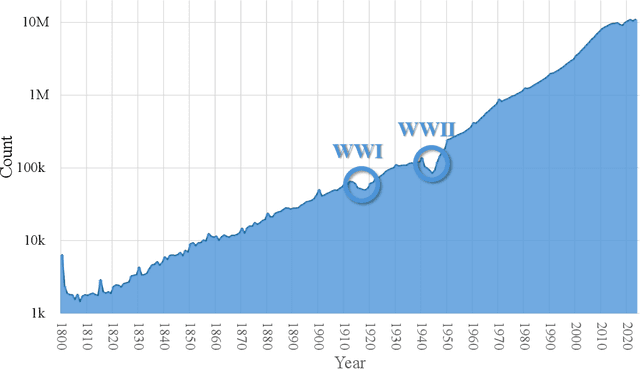
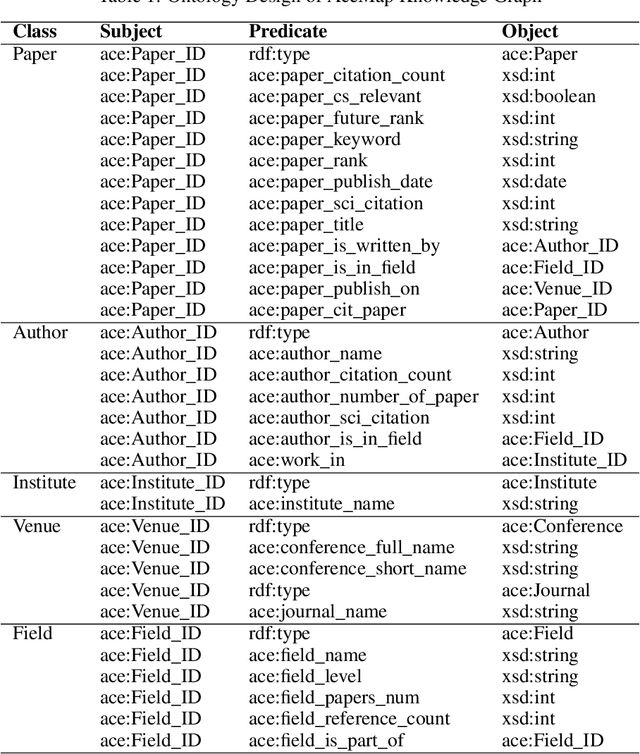

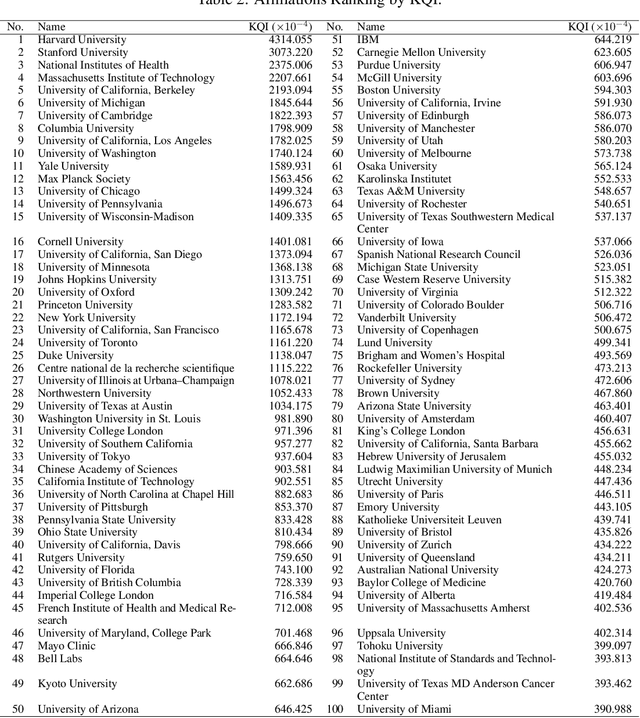
Abstract:The exponential growth of scientific literature requires effective management and extraction of valuable insights. While existing scientific search engines excel at delivering search results based on relational databases, they often neglect the analysis of collaborations between scientific entities and the evolution of ideas, as well as the in-depth analysis of content within scientific publications. The representation of heterogeneous graphs and the effective measurement, analysis, and mining of such graphs pose significant challenges. To address these challenges, we present AceMap, an academic system designed for knowledge discovery through academic graph. We present advanced database construction techniques to build the comprehensive AceMap database with large-scale academic publications that contain rich visual, textual, and numerical information. AceMap also employs innovative visualization, quantification, and analysis methods to explore associations and logical relationships among academic entities. AceMap introduces large-scale academic network visualization techniques centered on nebular graphs, providing a comprehensive view of academic networks from multiple perspectives. In addition, AceMap proposes a unified metric based on structural entropy to quantitatively measure the knowledge content of different academic entities. Moreover, AceMap provides advanced analysis capabilities, including tracing the evolution of academic ideas through citation relationships and concept co-occurrence, and generating concise summaries informed by this evolutionary process. In addition, AceMap uses machine reading methods to generate potential new ideas at the intersection of different fields. Exploring the integration of large language models and knowledge graphs is a promising direction for future research in idea evolution. Please visit \url{https://www.acemap.info} for further exploration.
Covidia: COVID-19 Interdisciplinary Academic Knowledge Graph
Apr 14, 2023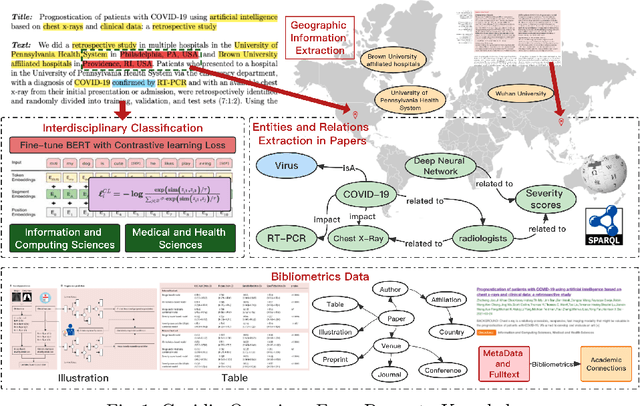

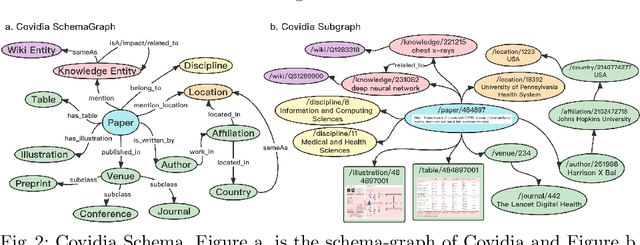
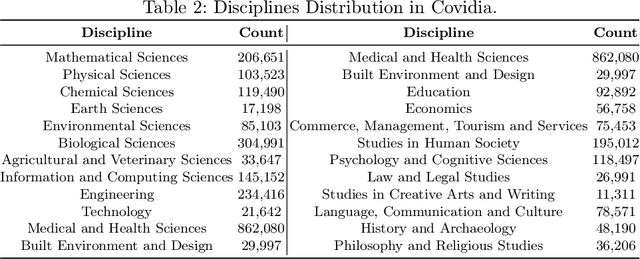
Abstract:The pandemic of COVID-19 has inspired extensive works across different research fields. Existing literature and knowledge platforms on COVID-19 only focus on collecting papers on biology and medicine, neglecting the interdisciplinary efforts, which hurdles knowledge sharing and research collaborations between fields to address the problem. Studying interdisciplinary researches requires effective paper category classification and efficient cross-domain knowledge extraction and integration. In this work, we propose Covidia, COVID-19 interdisciplinary academic knowledge graph to bridge the gap between knowledge of COVID-19 on different domains. We design frameworks based on contrastive learning for disciplinary classification, and propose a new academic knowledge graph scheme for entity extraction, relation classification and ontology management in accordance with interdisciplinary researches. Based on Covidia, we also establish knowledge discovery benchmarks for finding COVID-19 research communities and predicting potential links.
 Add to Chrome
Add to Chrome Add to Firefox
Add to Firefox Add to Edge
Add to Edge